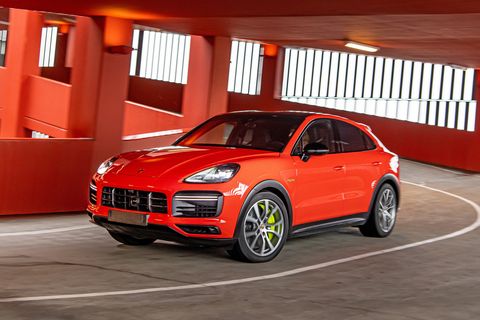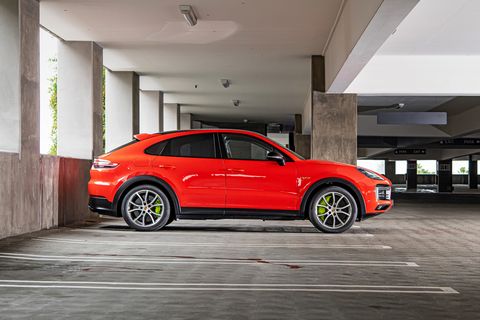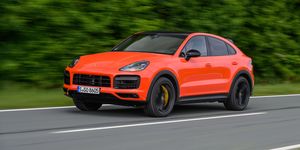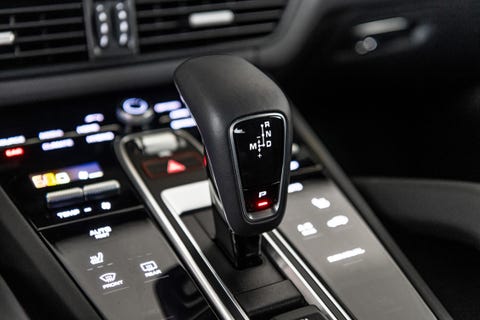View Photos

Jessica Lynn WalkerCar and Driver
The 2020 Porsche Cayenne Turbo S E-Hybrid Coupe makes it hard to hate on SUVs. Someone at Porsche went down the list of reasons the high-riding machines get a bad rap and crossed them out one by one. Weak-sauce performance? Nope, this one’s as spicy as a 670-hp ghost pepper. An overpowered affront to the planet? Oh look, its mighty twin-turbo 4.0-liter V-8 is partnered with a 134-hp electric motor for both extra performance and (somewhat) friendly fuel economy. A soulless bar of soap on wheels? Not so much. While the conventional squared-off Porsche Cayenne possesses pretty much the same traits, this sloped-back Coupe version looks a bit cooler, even if it’s less practical.
Power to Spare
The Cayenne Turbo S E-Hybrid Coupe and the conventional Cayenne Turbo S E-Hybrid SUV that we recently tested are the highest-powered versions of the latest Cayenne. They are also the most expensive. At $165,750 to start, you’ll need to shell out an additional $2500 for the Coupe version. Porsche doesn’t do anything for free, including giving you less roof than the regular Cayenne. Just make sure you opt for the $1720 head-up display in either of them, because you’re going to need all the reminders you can get that these SUVs are faster than they look. And that’s saying something for the Cayenne Coupe, which looks especially menacing in Lava Orange. The Coupe weighs about the same as the SUV and it should have no problem matching the long-roof’s 3.2-second time to 60 mph and 11.5 seconds quarter-mile run. Note: keep an eye on your speed, or ticket-writing public-servants will.
The Turbo S E-Hybrid’s secret weapon is its electric motor, which can interact with the gas engine in a few different ways, depending on the chosen drive mode. In some modes, both gas and electricity are used together to move you along. In others modes, the gas engine is the primary motivator while simultaneously turning the motor to recharge the 14.1-kWh battery pack. In Sport and Sport Plus settings, both fossil fuel and electrons are all on call to provide maximum acceleration and 670 horsepower. Slip into E-power and the gas engine remains sleeping while the vehicle whirrs along on electricity at speeds up to 83 mph—although that’ll only last about a dozen miles. If you want a Porsche that’s only powered by batteries, get a Taycan.
Even though the Turbo S E-Hybrid runs through its 14.1-kW juice quickly, it’s nice to be able to choose silent running for parking garages and early-morning departures or slow-rolling commutes. The different modes bring with them different accelerator-pedal calibrations, but for the most part the interplay between electric to gas power is seamless. Gear shifts from the eight-speed automatic transmission are unobtrusive as well. Unlike the similarly powerful Panamera Turbo S E-Hybrid, which utilizes an eight-speed dual-clutch unit, the Cayenne versions feature a torque-converter automatic that’s a bit more adept at towing. At 7700 pounds, the Cayenne Turbo S E-Hybrid’s towing capacity is respectably stout for an SUV, err coupe SUV, err thing.
The Moves to Match
Normally, if we call an SUV is sticky, it means someone has spilled a Slurpee in it. But in this case we’re referring to tire grip. Despite its mass, this top-level Cayenne adheres to the road like a melted gummy bear does to the bottom of a cupholder. The Cayenne Turbo S E-Hybrid’s behavior is unfazed by its awesome acceleration too, even when pressed into curvy, undulating roads. It has a lot of chassis tech to make this all possible: active anti-roll bars fore and aft, adaptive dampers, four-wheel steering, torque vectoring, on top of the Cayenne’s multilink front suspension. This giant Porsche indeed goes where you point it. We recorded a bonkers-for-a-ute 1.02 g’s of skidpad grip with the regular version on 21-inch Pirelli P Zero Corsa PZC4 summer tires, as well as an impressive 149-foot stop from 70 mph.
Should you be concerned that all that chassis gear and massive grip levels ruin its over-the-road refinement. The Turbo S E-Hybrid feels like it’s riding on air because it is. The active anti-roll bars automatically sense body roll and stiffen up to flatten out the ride. Porsche’s Active Suspension Management (PASM) damping adjusts for each wheel depending on the road conditions and driving style. If you opt for rear-wheel steering, the back wheels will turn in the opposite direction of the fronts at slow speeds to improve maneuverability. At higher speeds, they turn in phase with the fronts to boost stability. Because Porsche is very good at this stuff, you won’t notice that any of this technology is at play underneath you. You’ll just think, “Gosh, I’m going over two times the recommended speed around this turn.”
Making a Compromise
As a performance vehicle, the Cayenne Turbo S Coupe certainly holds its own, but what does it hold in terms of people and things? Pop the hatch and condense your expectations into smaller suitcases. You lose five cubic feet of cargo space in the hybrid Coupe compared to the standard hybrid Cayenne SUV, which makes for a relatively tidy 18 cubic feet of storage space behind the rear seats. However, back-seat headroom is sufficient for all but the tallest adults, and the doors open wide enough to allow for child seat—and child—wrangling.
Up front, can we take a moment to admire the black-and-silver houndstooth (Porsche calls it Pepita) upholstery in our well-equipped $192,590 example? It comes as part of the Lightweight Sport package, a $12,750 option—or $11,570 without the matte black trim in these photos—that includes lightweight 22-inch wheels and a carbon-fiber roof. Porsche claims the latter feature saves 46 pounds compared to the standard glass roof. Unfortunately, the Lightweight package is only available with the Coupe’s four-seat configuration, so if you want the standard three-person rear bench you’ll have to settle for the panoramic glass ceiling and plain leather. Maybe just ditch a family member, as the checker-pattern upgrade might be worth it. The rest of the interior is less flashy but no less pleasing. Soft leather, glossy carbon fiber, Alcantara trim, and a touch of brushed chrome combine for a design that offers an attractive detail to see or touch.
Unless you’re a Formula One driver, the Cayenne Turbo S E-Hybrid’s steering wheel might seem a little busy with buttons. However, it doesn’t take long to figure out how to scroll through the cockpit displays. A programmable button on the wheel helps to reduce the frequency of your reaches to the center touchscreen and the numerous surrounding controls sandwiched between it and the shift lever. That crowded center console layout, which doesn’t leave much space to put a smartphone, is one of our few complaints about the latest Cayenne. But those are still small gripes barely worth asking to speak to your dealer’s sales manager about. It’s much cooler to just get in and drive Porsche’s newest warp-speed brute of an SUV.
Source: Reviews - aranddriver.com








